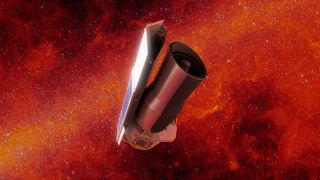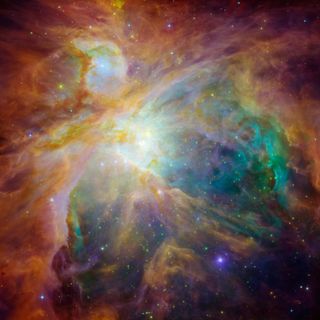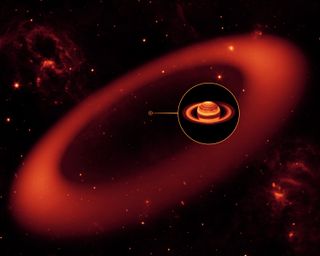NASA is turning off the Spitzer Space Telescope. Its infrared eye changed our view of the universe.
NASA is bidding goodbye to a premier space telescope, one that let scientists peer into the dusty corners of the universe.
The infrared Spitzer Space Telescope launched in 2003, kicking off a 2.5-year primary mission. Instead, it continued operating for a total of 16 years, gathering its final science data yesterday (Jan. 28). All that ends tomorrow (Jan. 30), when NASA will send the spacecraft its final commands. NASA spent about $1.36 billion on the project from start to finish. But no one can say that Spitzer didn't live up to the science goals with which it was launched.
"It was just exquisite, the type of data that Spitzer allowed us to observe," Farisa Morales, an astrophysicist at NASA's Jet Propulsion Laboratory in California, told Space.com. "It unveiled the universe: the old, the cold and the dusty."
Related: Gallery: The Infrared Universe Seen by Spitzer Telescope
Over the 16 years it operated, Spitzer's science work let astronomers stretch across time and space alike, thanks to its unique talent of observing the universe in infrared light. "[Spitzer] senses cool objects, so we can see through dust: We're lifting the cosmic veil on the universe," former mission manager Suzanne Dodd said during a NASA news conference held Jan. 22. "There's just a cornucopia of astrophysics objects out there that we can observe: nebulas, supernova, dying stars, stellar nurseries, the list goes on and on and it's really remarkable."
Perhaps Spitzer's most iconic work — in a field that was not a part of its initial portfolio, no less — was characterizing the seven exoplanets orbiting a star called TRAPPIST-1. Scientists using the observatory were able to tease apart the complicated orbital dance of those worlds to understand that all seven are about the size of Earth and three may be the right temperature to hold liquid water on their surfaces.
Spitzer's work has made the TRAPPIST-1 solar system one of the most familiar to exoplanet scientists and space fans alike. "It's the best-characterized solar system outside of our own," Mike Werner, project scientist for Spitzer, said during the news conference.
Get the Space.com Newsletter
Breaking space news, the latest updates on rocket launches, skywatching events and more!

Werner also pointed to the importance of lower-profile exoplanet research, like that in which Spitzer allowed scientists to analyze planetary systems around white dwarf stars that can pull shreds of debris into their atmosphere. "It's a very solid but somewhat roundabout way of studying the composition of extrasolar planetary systems, which really can't be done any other way," Werner said. "That's just one of several little gems that I followed with great delight over the years.”
White dwarf stars are quite old, but much of Spitzer's stellar work focused on younger stars as scientists tried to understand the life cycle of such objects. "We can't ever put a star in a lab and watch it start to finish," Luisa Rebull, an astronomer at the NASA Infrared Science Archive at the California Institute of Technology, which hosts Spitzer's data, told Space.com.
"The only way that we can understand how stars form," she said, "is by trying to study as many as possible and then statistically trying to say, 'OK, well, there's a lot that look like this, there's a lot that look like that,' and then trying to piece together the timescales and the story." Spitzer let scientists do just that.

The observatory also gave them enough data to conduct similar statistical work on stars surrounded by dust and debris, as Morales has done. "This is really nature talking to us," she said. "What we found with Spitzer for the first time is that there's a great number of stars around the solar neighborhood with dust in the terrestrial-planet zones, and that was very interesting, confirming that there is enough material to form terrestrial bodies like the one you and I evolved in."
In general, Morales is most interested in the ways Spitzer has shown us that our solar system isn't so special after all. She's struck by the similarities between our neighborhood and those studied by the observatory. "There's structure: there's belts, there's gaps, and likely baby planets may be forming within them," she said.
But Spitzer's observations have also directly informed our understanding of our solar system, since the telescope spent plenty of time observing our neighbors. In Spitzer's data, scientists discovered an extra ring for Saturn, with a massive circumference and tiny particles.

Spitzer also partnered with other missions. In 2005, when NASA deployed a spacecraft called Deep Impact to collide with a comet, Spitzer was ready, watching for the drama. "It was the first look at the primordial material buried beneath the crusty outer surface of a comet," Werner said of those observations.
And the telescope's legacy isn't just about science: Spitzer is responsible for plenty of stunning images of the universe around us. Those masterpieces are laborious compilations of numerical data, translated into colors the human eye can see.
As usual, astronomers have one comfort to see them through the end of a mission: the massive archive of data that Spitzer will leave behind. "There's so much more stuff, so many more things that are lurking in there for us to find," Rebull said of that data. "We're going to be learning things from Spitzer for decades."
- 50 Fabulous Deep-Space Nebula Photos
- With End in Sight, Spitzer Space Telescope Releases Glorious Nebula Images
- Zoom Through the Famous Orion Nebula with NASA's Incredible 3D Video
Email Meghan Bartels at mbartels@space.com or follow her @meghanbartels. Follow us on Twitter @Spacedotcom and on Facebook.

Join our Space Forums to keep talking space on the latest missions, night sky and more! And if you have a news tip, correction or comment, let us know at: community@space.com.

Meghan is a senior writer at Space.com and has more than five years' experience as a science journalist based in New York City. She joined Space.com in July 2018, with previous writing published in outlets including Newsweek and Audubon. Meghan earned an MA in science journalism from New York University and a BA in classics from Georgetown University, and in her free time she enjoys reading and visiting museums. Follow her on Twitter at @meghanbartels.
-
rod ReplyAdmin said:NASA is bidding goodbye to a premier space telescope, one that let scientists peer into the dusty corners of the universe.
NASA turns off the Spitzer Space Telescope this week. Its infrared eye changed our view of the universe. : Read more
"The only way that we can understand how stars form," she said, "is by trying to study as many as possible and then statistically trying to say, 'OK, well, there's a lot that look like this, there's a lot that look like that,' and then trying to piece together the timescales and the story." Spitzer let scientists do just that."
Spitzer documented cosmic high noon concerning stars forming too. "...these results show that star formation across the universe peaked between 2.3 and 3.8 billion years after the Big Bang and has been decreasing ever since.", Spitzer's Legacy, Sky & Telescope 139(1):18-25, 2020
The universe since the *beginning*, is winding down, not up.